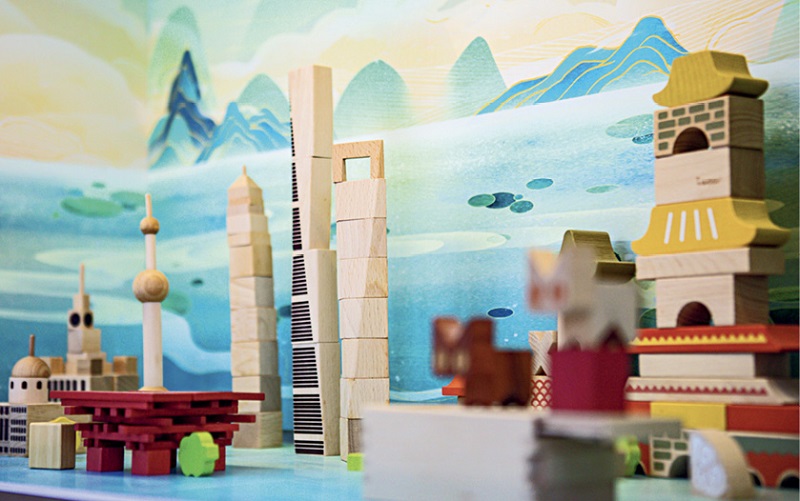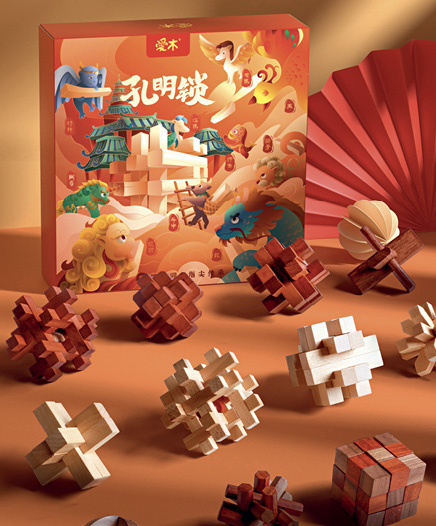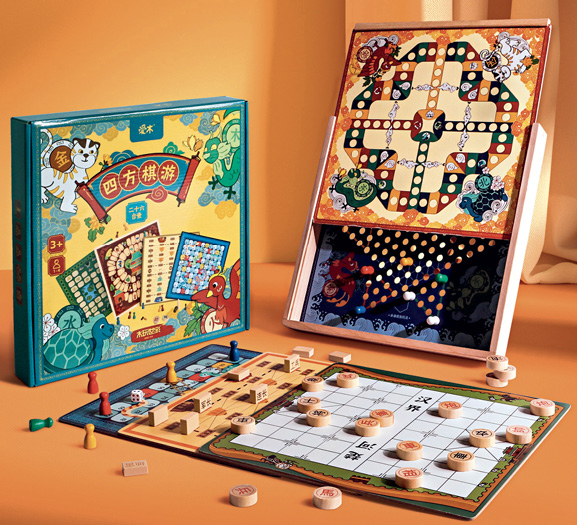The rise of the Chinese economy and China’s cultural confidence is driving the popularity of brands rooted in the unique Chinese culture.
Literally meaning a national wave or national trend, Guochao denotes a new consumer trend emerging in China in recent years. With the rise of the Chinese economy, domestic brands are embracing traditional cultural elements boosted by the Chinese pride in the achievements of the nation. Traditional culture has become a unique feature of Chinese brands going abroad and even foreign brands courting the Chinese market. From clothing and daily necessities to cell phones and cars, Guochao products are expanding. Huawei products, including cell phones, the sports products of former Olympic gymnast Li Ning, and other rising brands from China showcase both the charm of traditional Chinese culture and cultural confidence.

Muwan Shijia’s block toys are on display at the Nuremberg Toy Fair in Germany from January 27 to February 1, 2018.
Reputation Built Block by Block
Chishi Toy Factory in Yunhe, a county in east China’s Zhejiang Province, is one of the earliest wooden toy manufacturers in the mainland. It is a prime example of an industry spurred by Guochao. He Shouzhen, its founder, started experimenting with wooden toys in 1973 and 50 years on, its wooden toy brand Muwan Shijia is flourishing. The factory is now run by He’s grandson He Bin, who began exporting the innovative products that combine the natural charm of wood with traditional Chinese culture.
Wooden architecture has been a cornerstone of Chinese architectural history for thousands of years. A key component of that is the mortise and tenon joint, a technique used to join two pieces of wood by fitting them into each other without employing nails. Muwan Shijia launched a series of block toys that fit into each other using mortise and tenon joints and the products have amassed a large number of staunch fans both at home and abroad.
“Countries like Japan and South Korea use Chinese elements in animation and commercial products, which are hugely popular in the West. As inheritors of the Chinese culture, we certainly have more content to tap,” said He Bin. Traditional Chinese architecture, colors and other cultural elements, according to him, are a hit in other countries, creating great potential for the Chinese toy industry.
Last year, the China Toy and Juvenile Products Association held four trade fairs focusing on toys and other products for preschoolers and youngsters. They attracted more than 2,000 domestic and foreign enterprises and over 5,000 brands and 500,000 products.
Zeng Fanwen, executive director of the Cultural Industries Institute of Renmin University of China, believes Guochao reflects the strong momentum of “Made-in-China,” Chinese brands and the Chinese spirit. “The profound reason behind its rise is the enhancement of our national identity and cultural self-confidence. By drawing inspiration and creativity from traditional Chinese culture, it realizes the manifestation of Chinese aesthetics and the spread of national brands,” he said.
Zeng sees the development of the Guochao business as based on innovations in technology, products, brands, and culture, all of which provide new momentum for high-quality economic development. At the same time, Guochao combines traditional Chinese culture with today’s modern lifestyle, promoting traditional culture in daily life, thus providing a new path for cultural revival.
In 2014, Muwan Shijia launched a series of block sets featuring some famous cities and their landmark buildings. This series with traditional Chinese art images received a large number of orders at the famed Nuremberg Toy Fair in Germany. Also, by the end of 2022, the company’s mortise and tenon hut series had become a sensation. All this confirmed He Bin’s belief that the national style Guochao is Chinese manufacturers’ brand gene.
After that, Muwan Shijia launched more products, including a toy Kongming lock. Said to have been invented by someone called Zhuge Kongming over 2,000 years ago, the puzzle, based on a set of eight traditional Chinese cultural symbols, can be called the precursor of Rubik’s Cube, and is regarded as a traditional Chinese intellectual toy. Muwan Shijia also rolled out a chess game in which the chess pieces are images of mythical beasts.
Muwan Shijia’s products have won recognition in the international market. “We are trying to make the international market see that brands from China can design [global] products that embody the Chinese culture and Chinese spirit,” He Bin said.

A model of Kongming Lock, a traditional Chinese educational toy, which Muwan Shijia made.
The Wheels of Fortune
Last year, another Chinese brand saw a meteoric rise. Montresor, a high-end children’s bicycle, became a bestseller on Tmall, one of the largest Chinese e-commerce platforms, for its green materials and striking design. Zhao Lanmin, founder of the brand, said when it first started operating in 2019, it sold around 3,500 units at home annually. But in 2022, the figure jumped to around 110,000 units. This year, the target is 200,000.
In the process, Zhao has spotted a dramatic rise in customers’ interest in Chinese elements, especially among the younger generations. “With the revival of traditional culture in recent years, Oriental culture has a great appeal for young people,” he said. Zhao’s team has added iconic Chinese elements such as images of the Forbidden City and Buddhist art from the Dunhuang Caves in northwest China to provide customers a different visual experience.
Last year, Montresor began to be sold in the U.S. on Amazon and this June, it is set to participate in a Frankfurt expo in Germany to explore the European market.

A chess game designed by Muwan Shijia features a range of elements from Chinese legends.
The Power of Gen Z
Gen Z has become a powerful driver for the development of national trend products. They are boldly experimenting with domestic brands in multiple sectors, helping them to gain a place in the competitive market.
Zeng Fanwen of Renmin University calls the development of Guochao part of an important historical mission. It is playing an important role in building a new development pattern with domestic consumption as the main driver of the economy, complemented by exports. It is also presenting the image of China to the world.
However, while Guochao has brought development opportunities and dividends for enterprises, it also faces problems such as product homogenization and excessive marketing.
He Bin thinks that each industry and category will have trendsetting companies spreading the traditional culture overseas, and hopes more and more companies would emerge with original design and innovation capability.
To ensure the development of Guochao, Zeng’s suggestion is that companies improve their quality, content, and digital development. They should embrace the digital economy by strengthening digital creativity and digital marketing, expand their platforms while establishing themselves in the domestic market, and go abroad to enhance the international competitiveness and influence of Chinese brands.
Also, attention must be paid to consumers’ consumption experience and aesthetic preferences. Moreover, independent intellectual property rights should be established and Chinese companies should tell the stories of their brand development.